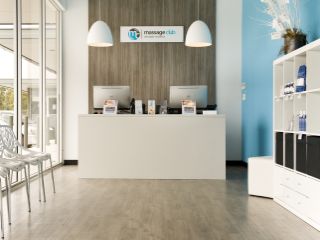
Walk into any mature Massage Club outlet in Perth on a Friday and Saturday and you will see a business taking up to 60 percent of its turnover over these two days.
The first outlet opened four years ago with nine rooms.
“We didn’t know what was a good massage,” reveals franchisor Grant Jones, an experienced franchisee and franchisor in the food and retail sector, but with no benchmarks for the massage sector.
“The only way to measure was to make sure therapists are qualified. That wiped out a huge percentage of massage therapists, who might be good but weren’t qualified.
“With this policy in place, it takes away our requirements for time spent on teaching people to massage.”
Therapists bring something personal to the job – consistency comes in touchpoints like client greetings, and professional standards.
“We made a decision to pay under an award, the hair and beauty industry, and that created consistency.”
There are a dozen massages on the treatment menu: 40 percent are remedial, 30 percent are deep tissue, 20 percent are relaxation; the remainder are sports, reflexology, hot stones, and seniors.
The hot stone massage is an opportunity for the franchisee to upsell, to try and amplify the experience, says Jones, “to try and add value to the massage experience”.
“We educate the client that you can trust the therapist but you can also trust the brand. We’re about building trust.”
This membership model right now has about 1300 members.
It’s about “volumetrics” says Jones. “We’re not discounting, we refuse to focus on price. Manning a clinic is the major cost but if you do 200 massages, the cost is quite reasonable, just $8 to $10 per massage.”
Since opening up the business with a third founder, Jones and fellow director Matthew Goss have assumed complete control of the business (although Goss has no day-to day involvement) and most recently appointed franchise lawyer Tamra Seaton and former food franchisor Steve Hansen to the board.
That puts them in franchise-ready mode, says Jones, poised to strengthen the brand throughout Western Australia before heading south to Tasmania next year to open one in Launceston, two in Hobart, and then expanding into South Australia.
“We’ve been waiting until the foundations are right. We wanted to get the board because accountability is important.”
“I’m nervous of someone else representing the brand. The profit and loss statement is a result of a business being run, it doesn’t tell you about the business,” he says.
“I used to think we were in the massage business but we’re in the membership business and we offer a massage. When you’re in a tough economy, those 800 clients a month are so important. This means we can commit to therapists and it helps us keep them in regular work.
“This is so different to work in an industry where people love what they do,” says Jones. “It’s very different from fast food. We have an environment where people have invested in their learning and have a desire to heal. It’s a wellness perspective.”
The message to the market is ‘Join the club’; the message internally is ‘Need for speed’.
Growing the massage market
There’s a newcomer in the field, and Jones is happy to see another business focus on this service.
“I’ve got a lot of admiration for Massage Envy, and how it has grown the industry in the US. I think it’s great they’re here, another franchise with muscle.
“If you don’t have a competitor, you’re a monopoly and it’s harder to sell. Now we’re a considered option.
“We can be a great contributor to changing the perception of massage industry.
“We’ve done 600 hours of massage now, we have 13000 memberships. When people are coming back, it’s the ultimate confidence.”
Finding the right franchisee
The current model works well in outer Perth: standard sites requiring 200 to 250sqm sites to house a minimum of 12 treatment rooms.
It will be more challenging to take this model to city centres and the eastern seaboard. “If I want to move into cities, we have to get the model to 140sqm and eight rooms.
“There are more beauty businesses closed than open. So finding sites that can convert into our business is a strategy, and we expect to convert a business in the next three to six months,” says Jones.
The business has to be owner-operated, but multi-unit operation is part of the strategy.
“The franchisee I’m looking for is a believer, who thinks this is an amazing business. We’re not a spa, we don’t want to be a spa. When people tell us it looks a bit clinical, that’s great.
“This is good for someone looking to change their lifestyle. We don’t yet trade on a Sunday, because of penalty rates.
“People who are coming out of a gym or the health industry, people with franchising experience who’ve done high volume business but are now looking for something with more balance.
“What’s really important is that they can provide a comfortable sell.”
The long term goal is 50 franchises in the next five years.
The cost of a franchise? Franchise buyers will need to invest between $200,000 and $300,000 (this can be influenced by landlord contributions), allowing for working capital. The initial franchise fee is $50,000 for a 15 year term, and ongoing fees are: seven percent franchise fee, three percent for marketing, and a one percent levy for technology.

